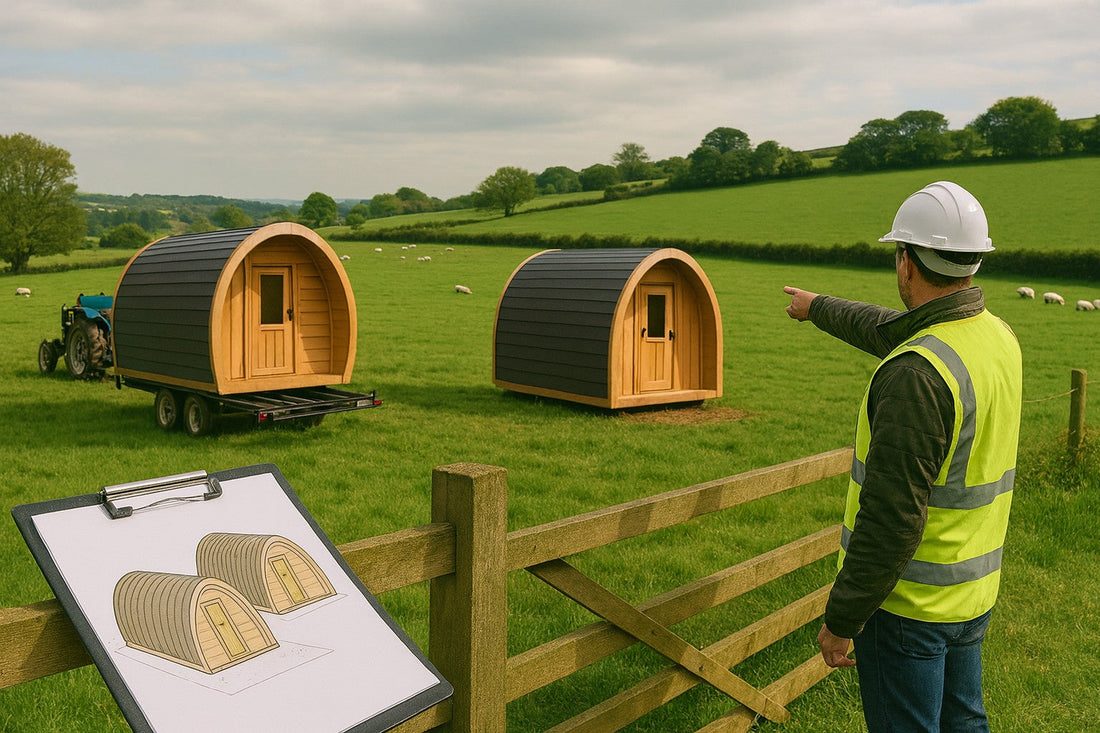
Planning Permission for Farm Glamping: What UK Farmers Really Need to Know
Thinking about starting a glamping site on your farm? Before you buy pods or pitch tents, there’s one thing you need to get your head around: planning permission.
It’s the make-or-break part of launching a glamping business — and it doesn’t have to be as painful as you might think. In this guide, we’ll walk you through what UK farmers in England, Scotland, and Wales need to know about planning permission for small-scale glamping setups (1–5 pods).
What is Planning Permission?
In simple terms, planning permission is official approval from your local council to change how you use your land or build something on it.
If you're turning part of your field into a glamping site — even just a couple of pods — that usually counts as a “change of use” from agriculture to tourism. You may also be adding structures (like glamping pods, loos, or gravel paths), which can count as development in the eyes of the planners.
The question is: do you always need full planning permission? The short answer: not always. That’s where permitted development rules come in.
The 28-Day Rule (and the 60-Day Rule in England)
Under something called Permitted Development Rights (PDR), you may be able to use your land temporarily for glamping without needing full planning permission.
Here’s how it breaks down:
🏕 England
- You can use your land for tent camping for up to 60 days per year
- No permanent structures allowed (pods often don’t count)
- You must notify your local council beforehand with a site plan and proposed dates
🏕 Wales
- You’re limited to 28 days per year
- A consultation is underway to increase this to 60, but for now, it’s still 28
- Same rule: no fixed structures, no mains plumbing, no permanent tracks
🏕 Scotland
- The 28-day rule still applies
- You may get temporary flexibility, but there’s no formal extension
- Most small-scale glamping setups will require planning permission
Important: These rules only apply if your site is truly temporary — no fixed bases, no digging in water or electric lines, and everything is packed away after each stint.
Does the 28/60-Day Rule Work for Pods?
In most cases, no. Planning officers are strict about what counts as "temporary." Most pods:
- Can’t be packed away easily
- Sit on hardstanding or platforms
- Are connected to utilities
So if you’re using Snap Pods, shepherd huts, or similar structures, you’re almost certainly going to need full planning permission — especially if you plan to open more than a few weeks per year.
When You’ll Definitely Need Full Planning Permission
If any of these apply, it’s time to submit an application:
- You want to run a site for more than 28/60 days per year
- You’ll have fixed structures (like pods or toilet blocks)
- You’re connecting to mains utilities
- You’re adding roads, car parks, or decking
- You’re in a protected area (National Park, AONB, Green Belt)
- You want to run the site as a commercial business
The moment your setup looks “permanent,” planners will ask for a full application.
What Does the Planning Process Involve?
If you’re going ahead with full planning, you’ll need to submit:
- A site plan and drawings
- A planning statement
- Possibly ecology, highways or flood risk reports
- A fee (usually a few hundred pounds)
You can do it yourself via the Planning Portal, or hire a planning consultant to help. Many councils are open to farm diversification — just be ready to answer questions about access, traffic, noise, landscape impact, and waste management.
Snap Pod’s Planning-Friendly Design
This is where Snap Pod shines.
Snap Pods are:
- Modular – they arrive in sections and are easy to position
- Movable – they meet the legal definition of a “caravan” in many cases
- Off-grid – no need to dig trenches or pour concrete
This means less impact on your land, and a better chance of planning success. You can even trial one under temporary permission before scaling up.
How Long Does Planning Take?
Most applications are decided within 8 weeks, but it can take longer if:
- Your land is in a protected area
- Your site needs environmental reports
- There are objections from neighbours or local groups
TIP: Talk to your local planning authority before you submit. They’ll often offer pre-application advice — worth its weight in gold.
Common Mistakes Farmers Make
❌ Starting work before getting permission — leads to enforcement notices
❌ Assuming the 28-day rule applies to pods — it rarely does
❌ Not considering access or traffic — huge red flag for planners
❌ Using permanent services like mains drainage — counts as development
❌ Not checking local policies — some areas are more supportive than others
Other Considerations Beyond Planning
Planning is just the first hurdle. You may also need:
- A site licence (required if you’re open more than 60 days or have structures)
- Fire risk assessments
- Public liability insurance
- Disabled access (required under the Equality Act 2010)
Don’t worry — we’ll cover all of that in future posts.
Conclusion: Start With a Clear Plan
Planning permission might seem like a faff, but it’s there to protect the land and community. If you approach it well, most farm glamping applications do get approved — especially when the site is small, low impact, and supports rural tourism.
If you’re not sure where to begin, that’s what we’re here for.
👉 Book a free consultation with Snap Pod and we’ll help you figure out whether your land is suitable and what your next steps should be.planning permission
